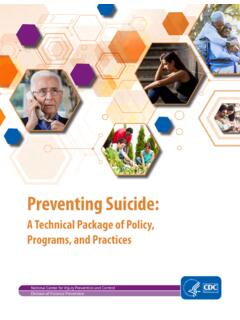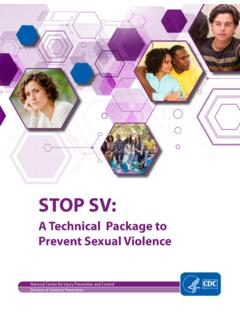Transcription of Emotional, Mental, and Social Health Unit Plan - Weebly
1 6th Grade Emotional, Mental, and Social Health Unit Plan Diana Crew P a g e | 2 Table of Contents Unit 3 Unit 4-5 Unit Plan 6 Unit Plan 7 National Health Education Standard Performance 8 Unit Block 9 Unit Special Considerations ( contextual factors)..pp. 10-12 Lesson 13- 38 Unit Assessment 39-51 Unit Resources and 52 P a g e | 3 Unit Description Grade: 6th Content Area: Emotional, Mental, and Social Health Skills: Identifying relationships, demonstrating personal responsibility, communicating clearly, demonstrating and identifying body language, and choosing and identifying the right behavior, Identifying the key characteristics of a good friend, deciphering and identifying the differences between positive and negative peer pressure, identifying, understanding, and demonstrating how to say know through scenarios, identifying and understanding conflict, identifying and understanding conflict with peers.
2 Identifying and understanding bullying, identifying and demonstrating the decision making skills through real life scenarios, identifying an I-message, identifying the parts of an I-message, creating an I-message, using an I-message in a scenario, identifying and understanding what stress and stressors are, identifying and understanding distress and eustress, demonstrating and identifying how to respond to stress in healthy ways, and identifying the effects that stress has on the body Number of Lessons: 6 Length of Class Periods.
3 45 minutes P a g e | 4 Unit Rationale In the United States, approximately 6 to 9 million children and adolescents have serious emotional Research shows that one of five children and adolescents aged 9 to 17 years experience symptoms of mental Health problems that cause some level of impairment in a given Expenditures for children s mental Health services were nearly $ billion in 1998 a threefold increase from ,4 Left untreated, mental Health disorders in children and adolescents lead to higher rates of suicide , violence, school dropout, family dysfunction, juvenile incarcerations, alcohol and other drug use, and unintentional injuries.
4 Schools can play a vital role in creating safe, nurturing school environments and providing care to students with emotional or behavioral problems. According to the School Health Policy and Programs Study of 2000, three-fourths of schools have a part-time or full-time guidance counselor, two-thirds have a part-time or full-time psychologist, and slightly more than 40 percent have a part-time or full-time Social Student Assistance Programs A Student Assistance Program (SAP) provides services designed to assist students experiencing personal or Social problems that can impact school performance, physical Health , or overall well-being.
5 Of states and of districts require that SAPs be offered to all students. of elementary, of middle/junior high, and Health Services of states and of districts require that districts or schools provide one-on-one or small-group discussions on suicide prevention to students when needed (not including classroom instruction). of districts have arrangements with organizations or professionals not located on school property to provide one-on-one or small group discussions on suicide prevention to students when needed.
6 Standard 2: Students will analyze the influence of family, peers, culture, media, technology, and other factors on Health behaviors. P a g e | 5 Standard 4: Students will demonstrate the ability to use interpersonal communication skills to enhance Health and avoid or reduce Health risks. Standard 5: Students will demonstrate the ability to use decision-making skills to enhance Health . Standard 7: Students will demonstrate the ability to practice Health -enhancing behaviors and avoid or reduce Health risks. P a g e | 6 Unit Goals Goals to gain through this communication unit: Express feelings in a healthy way.
7 Engage in activities that are mentally and emotionally healthy. Prevent and manage conflict and stress in healthy ways. Use self-control and impulse-control strategies to promote Health . Seek help for troublesome feelings. Be empathetic toward others. Carry out personal responsibilities. Establish and maintain healthy relationships. P a g e | 7 Unit Objectives SWBAT identify what a relationship and personal responsibility are. SWBAT identify the differences between aggressive, assertive, and passive behaviors are.
8 SWBAT demonstrate and analyze different types of body language during the body language activity. SWBAT demonstrate skills for refusing various offers. SWBAT identify the four qualities that make a good friend. SWBAT identify what a conflict is. SWBAT identify what bullying is. SWBAT demonstrate the ability to express their feelings by writing a complete I-message. SWBAT identify the many parts of an I-message. SWBAT identify what an emotion and a hormone are. SWBAT identify what mental Health and emotional Health are.
9 SWBAT demonstrate a healthy way to manage their anger. SWBAT define Stress, stressors, distress and eustress. SWBAT recognize at least 3 different effects stress has on our bodies. SWBAT identify different stressors and label them either distress or eustress. SWBAT identify healthy and unhealthy options to deal with stress. P a g e | 8 National Health Education Standards Performance Indicators Health EDUCATION STANDARD 2 Students will Analyze the influence of family, peers, culture, media, technology and other factors on Health behaviors.
10 Health EDUCATION STANDARD 4 Students will Demonstrate the ability to use interpersonal communication skills to enhance Health and avoid or reduce Health risks. Health EDUCATION STANDARD 5 Students will Demonstrate the ability to use decision-making skills to enhance Health . Benchmarks Linked to Objectives Describe the interrelationships of mental, emotional, Social , and physical Health during adolescence. Demonstrate healthy ways to express needs, wants, and feelings including I messages and assertive communication strategies.




